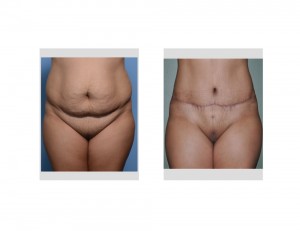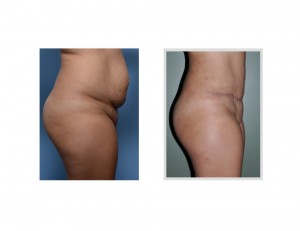Background: Tummy tucks are uniformly successful at reshaping the abdominal wall through the removal of excess skin and fat. While the amount of abdominal wall tightening is one criteria by which tummy tucks are judged, they are equally critiqued by the scars that are needed to create it. The fear of most tummy tuck patients is the long horizontal scar and whether it will be an acceptable trade-off for the abdominal tissue removal.
The appearance of a tummy tuck scar is influenced by many factors, particularly the skin type on which it is performed. The more pigment that is naturally in the skin, the more likely the scar after surgery will be noticeable. Ironically this is less of a concern in the darkest skin pigments. (e.g., African Americans) Intermediate skin pigments, like in Asians and Hispanics for example, have a tendency to over react with pigmentation as it has been injured and heals. The development of hyperpigmentation can make scars very noticeable and it rarely subsides with time unless treated early.
Case Study: This 37 year-old Asian female male wanted to improve the shape of her abdomen and waistline which had been significantly changed by multiple pregnancies and weight gain.


The development of areas of darker skin next to scars after surgery is known is known as post-inflammatory hyper pigmentation (PIH). A variety of ways to prevent/treat these type of skin scars including topical scar gels/tapes. Some of these topical treatments do contain agents to quell a hyperpigmentation response. While none of these scar treatments have ever been proven to be superior to another, their uses are not associated with causing any other problems either. When topical scar treatments are indicated, I find the use of 3M Micropore skin tape to be both simple and effective. Taping the scar for months after surgery is very useful. Should hyperpigmentation develop, topical bleaching agents can be applied with the tapes.
Case Highlights:
1) Tummy tuck surgery can be done in any woman of any ethnicity with equally successful results.
2) Women with intermediate pigmented skin are at risk for more visible tummy tuck scars due to a hyperpigmentation response.
3) Postoperative scar taping and use of bleaching agents can be useful treatments to prevent or treat tummy tuck scar hyperpigmentation in ethnic patients.
Dr. Barry Eppley
Indianapolis, Indiana



